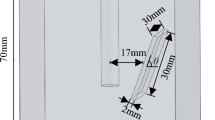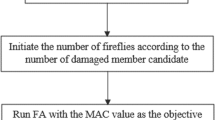Abstract
The distinct characteristic of subcritical propagation requires at least two control parameters to completely express expansion of cracks in the concrete. The basic definition of crack tip opening displacement (CTOD) is corrected based on the monitored variable of crack mouth opening displacement (CMOD). The improved CTOD criterion, called the double CTOD d criterion, for the abnormality diagnosis of cracks in the concrete is constructed based on the fictitious crack model and linear asymptotic superposition assumptions of the concrete. The double CTOD d criterion is verified using two specimens of three-point bending notched beam. The verification results are reasonable and correct. The establishment of the double CTOD d criterion lays a solid theoretical foundation for the abnormality diagnosis of cracks in concrete structures (such as concrete dams) based on CMOD.
Similar content being viewed by others
References
International Commission on Large Dams. Inspection of Dams Following Earthquakes-Guidelines, Bulletin 62. Paris: Committee on Seismic Aspects of Dam Design, 1988
Demmer W, Huber H, Lombardi G, et al. Remedial Project for Kolnbrein Arch Dam, Design and Construction. Carinthia: Osterreichische Draukraftwerke, 1991
Lombardi G. Kolnbrein dam: An unusual solution for an unusual problem. Water Power Dam Constr, 1991, 6: 31–34
Chen Z L, Ru N H. Cracking and Leaking Accident and Reinforcement of Foreign High Arch Dams. Shanghai: Shanghai Dam Technology Consulting Company, 2001
Ru N H, Jiang Z S. Accident and Safety of Large Dams·Arch Dams. Beijing: China Water Power Press, 1995
Li Z, Chen F, Zheng J B, et al. Analysis and Studies on Project and Major Technical Issues of Super-High Arch Dams. Beijing: China Electric Power Press, 2004
Pan J Z, Xiong S Z. Deformation failure and repair of Zeuzier arch dam in Switzerland. Large Dam Safety, 1987, 1: 2–22
Honghton D L. Measures being taken for prevention of cracks in mass concrete at Dworshak and Libby dam. In: the 10th International Congress on Large Dams, Paris, 1970. 241–271
Swanson A A, Sharma R P. Effects of the 1971 San Fernando earthquake on Pacoima arch dam. In: Proceedings of the 13th Congress of International Commission on Large Dams, New Delhi, India, 1979. 797–824
Brunner W J, Wu K H. Cracking of the Revelstoke concrete gravity dam mass concrete. In: the 15th International Congress on Large Dams, Paris, 1985. 1–22
Li Z L, Ren Q W. A research review of concrete arch dam heel cracking. Adv Sci Tech Water Res, 2004, 3: 62–65
Chopra A K, Chakrabarti P. The Koyna earthquake of december 11, 1967, and the perfomance of Koyna dam. Dissertation of Doctoral Degree. Berkeley: Earthquake Engineering Research Center, University of California, 1971
Wieland M, Brennerand R P, Sommer P. Earthquake resiliency of large concrete dams: Damage, repair, and strengthing concepts. In: the Proceedings of 21th Congress of International Commission on Large Dams, Montreal, Canada, 2003. 388–397
Shen C S, Lu S J, Lin Y C. Reinforcing scheme and its effect of crack in Chencun gravity arch dam. J Hohai Univ, 1994, 22: 15–22
Xing L S, Chen K. Long-term research on horizontal cracks at EL. 105 m of downstream of Chencun arch dam. Large Dam Safety, 2009, 6: 20–25
Gao H B. Study on the determination of mode I and mode II fracture parameters for concrete. Dissertation of Doctoral Degree. Dalian: Dalian University of Technology, 2008
Li X H, Gu C S, Zhao B. The mutation model of crack in dam. Int J Hydroelectr Energ, 2000, 18: 16–18
Li X H, Xu H Z, Gu C S, et al. Abnormality diagnosis of cracks based on wavelet analysis and cusp catastrophe model. J Hohai Univ (Nat Sci), 2005, 33: 301–305
Li X H, Xu H Z, Gu C S, et al. Detecting abnormality point of dam crack based on phase plane. J Basic Sci Eng, 2007, 15: 177–182
Bao T F, Yu H. Detection of subcritical crack propagation for concrete dams. Sci China Ser E: Tech Sci, 2009, 52: 3654–3660
Gu C S, Li Z C, Xu B. Abnormality diagnosis of cracks in the concrete dam based on dynamical structure mutation. Sci China Tech Sci, 2011, 54: 1930–1939
Kaplan M F. Crack propagation and the fracture of concrete. J Am Concr Inst, 1961, 58: 591–610
Ansari F. Analysis of Micro-Cracked Zone in Concrete. Elsevier: Fracture Toughness and Fracture Energy of Concrete, 1986. 226–238
Jacquot P, Rastogi P K. Speckle Metrology and Holographic Interferometry Applied to the Study of Cracks in Concrete. Elsevler: Fracture Mechanics of Concrete, 1983. 113–156
Jacquot P. Interferometry in Scattered Coherent Light Applied to the Analysis of Cracking in Concrete. Ingraffea: Fracture Mechanics of Concrete: Material Characterization and Testing, 1984. 161–194
Li B K. Study of Concrete Fracture Mechanics by Laser Speckle Method. Beijing: Water Conservancy and Electric Economic Management Institute, 1985
Xu S L. Concrete Fracture Mechanics. Beijing: Science Press, 2011
Bažant Z P, Becq-Giraudon E. Statistical prediction of fracture parameters of concrete andimplications for choice of testing standard. Cem Concr Res, 2002, 32: 529–556
Refai T M E. Fracture behavior of concrete beams in three-point bending considering the influnce of size effects. Dissertation of Doctoral Degree. Kansas: Kansas State University, 1987
Jenq Y S, Shah S P. Two parameter fracture model for concrete. J Eng Mech, 1985, 111: 1227–1241
Xu S L, Reinhardt H W. Determination of doubel-K criterion for crack propagation in quasi-brittle fracture, Part I: Experimental investigation of crack propagation. Int J Fract, 1999, 98: 111–149
Xu S L, Reinhardt H W. Determination of doubel-K criterion for crack propagation in quasi-brittle fracture, Part II: Analytical evaluating and practial measuring methods for three-point bending notched beams. Int J Fract, 1999, 98: 151–177
Xu S L, Reinhardt H W. Determination of doubel-K criterion for crack propagation in quasi-brittle fracture, Part III: Compact tension specimens and wedge splitting specimens. Int J Fract, 1999, 98: 179–193
Xu S L, Reinhardt H W. A simplified method for determining double-K fracture parameters for three-point bending tests. Int J Fract, 2000, 104: 181–208
Xu S L, Zhao G F. A double-K fracture criterion for the crack propagation in concrete structures. China Civil Eng J, 1992, 25: 32–38
Xu S L, Reinhardt H W. Crack extension resistance and fracture properties of quasi-brittle softening materials like concrete based on the complete process of fracture. Int J Fract, 1998, 92: 71–99
Reinhardt H W, Xu S L. Crack extension resistance based on the cohesive force in concrete. Eng Fract Mech, 1999, 64: 563–587
Hillerborg A, Modeer M, Peterson P E. Analysis of crack formation and crack growth in concrete by means of fracture mechanics and finite elements. Cement Concrete Res, 1976, 6: 773–782
Wang H. Quantitative assessment of fatigue and fracture properties of materials. Dissertation of Doctoral Degree. Xi’an: Northwestern Polytechnical University, 2002
Brook D. Elementary Engineering Fracture Mechanics. Beijing: Science Press, 1980
Jenq Y S, Shah S P. A fracture toughness criterion for concrete. Eng Fract Mech, 1985, 21: 1055–1059
Petersson P E. Crack growth and development of fracture zones in plain concrete and similar materials. Division of Building Materials, Lund Institute of Technology, Report TVBM-1006, Sweden, 1981
Reinhardt H W, Cornelissen H A W, Hordijk D A. Tensile tests and failure analysis of concrete. J Struct Eng, 1986, 112: 2462–2477
Bueckner H F. A novel principle for the computationof stress intensity factors. Angew Math Mech, 1970, 50: 529–546
Rice J R. Some remarks on elastic crack-tip stressfields. Int J Solid Structs, 1972, 8: 751–758
Sha G T, Yang C T. Weight functions of radial cracks emanating from a circular hole in a plate. Fract Mech, 1986, 905: 573–600
Glinka G, Shen G. Universal features of weight functions for cracks in mode I. Eng Fract Mech, 1991, 40: 1135–1146
Kumar S, Barai S V. Determining the double-K fracture parameters for three-point bending notched concrete beams using weight function. Fatig Fract Eng Mater Struct, 2010, 33: 645–660
Tada H, Paris P C, Irwin G. The Stress Analysis of Cracks Handbook. Hellertown: DelResearch Corporation, 1985
Zhao J S. Fracture Mechanics and Fracture Physics. Wuhan: Huazhong University of Science and Technology Press, 2003
Refai T M E, Swartz S E. Fracture Behavior of Concrete Beams in Three-Point Bending Considering the Influence of Size Effects. Report No. 190, Engineering Experiment Station, Kansas StateUniversity, 1987
Author information
Authors and Affiliations
Corresponding author
Rights and permissions
About this article
Cite this article
Li, Z., Gu, C. & Wu, Z. Abnormality diagnosis of cracks in the concrete based on double crack tip opening displacement criterion. Sci. China Technol. Sci. 56, 1915–1928 (2013). https://doi.org/10.1007/s11431-013-5275-5
Received:
Accepted:
Published:
Issue Date:
DOI: https://doi.org/10.1007/s11431-013-5275-5




